Políticas de publicación
Publishing policies
OPEN ACCESS
ARQUISUR Revista is an open access, non-profit publication. There are no charges for receipt, review, evaluation, publication or access to its contents. It is distributed under a Creative Commons CC Attribution – Non-Commercial – No Derivative Works (by-nc-nd) License: Commercial use of the original work or the generation of derivative works is not permitted. This license is not a free one, and is the closest to traditional copyright.

DISCHARGE
The criteria exposed in the articles are the exclusive responsibility of their authors and do not necessarily reflect the opinion of the Editorial Committee or the Technical Editorial Management. The rights to published articles belong to their authors or publishers. The authors assign their publication rights to the Publishing Center of the National Univesrity of the Litoral of Santa Fe, Argentina.
Arquisur Revista implements a self-archiving deposit policy, according to which the author registered in the repository uploads his work following a series of steps that include the description (type, title, etc.), attachment of the files and adhesion to the general policy of the publication, consideration taking of the Creative Commons license and finally confirmation of the data.
The authors express, by the mere fact of confirming their data in the system, that they are the owners of the economic rights of the works, which are deposited as a voluntary collaboration without charge. The authors assume full responsibility for legal violations that infringe intellectual property. Arquisur Revista commits to remove from circulation those elements that constitute a violation of intellectual property rights.
ARBITRATION AND EDITING PROCEDURE
The steps following the author’s deposition of the material are:
a) Form review: it is the responsibility of the Editorial Secretariy. If the submitted material is complete and adjusts to the instructions given, it is accepted for evaluation and communicated to the author. Otherwise, it is returned with the corresponding observations.
b) Content evaluation: the Technical Editorial Management sends each of the accepted articles for evaluation, after eliminating all authorship references, to a minimum of two referees selected among the members of the Scientific Committee, according to the following criteria:
• Both referees must correspond to the thematic axis of the article.
• The referees are not native from the same country as the author of the article.
• The referees must comply with the Evaluation Form provided to them, the ethical criteria of the publication and the stipulated deadlines.
c) Submission to the Editorial Committee: the Technical Editorial Management submits the results of the arbitration, which may be:
• ACCEPTED. The article/text is ready to be published given the fact that it has received two favorable evaluations.
• CONDITIONAL ACCEPT. The article/text requires minor corrections but, in general, it would be ready to be published. In this case, it is returned to the author with a deadline including the suggestions made by the referee(s).
• RESEND. The article/text requires important corrections but, in general, it would be ready to be published after implementing the changes suggested by the referee. It is resent to the author with the suggestions. The author forwards the material, which is again refereed by the same evaluator.
• REJECTED. The article/text is not acceptable for publication. –the author is informed.
d) The Editorial Committee decides both which articles are published and in which of the issues of the annual volume.
e) The Technical Editorial Management starts the editorial process consisting of the announcement to the authors of the decision of the Editorial Committee, setup and page layout design, style and both orthographic and typographic review.
f) Send to the administrator of the UNL Virtual Library for the publication of the respective issue on the official website of the journal, after assigning the DOI to each element.
PUBLICATION
The Editorial Committee is the body that ultimately decides on the articles and material to be published in general. The Technical Editorial Management is responsible for the technical editing process of the articles selected by the Editorial Committee. This process includes ortho-typographical correction, style review and graphic design of the articles for reading and downloading in PDF format. Once the layout, correction and revision process is completed, the magazine is published on its official website of the Virtual Library of the National University of the Litoral (UNL) https://bibliotecavirtual.unl.edu.ar/ and on the platform of the Association of Latin American Architecture Magazines (ARLA) respecting the following schedule:
First issue of the year: Second half of June. Publication period: June -November
Second issue of the year: Second half of December. Publication period: December - May
PREVENTION OF ETHICAL MISCONDUCT
The guiding principle of ARQUISUR Revista is to preserve intellectual values and freedom of thought and expression based on academic ethics and good practices of all the actors involved (authors, members of editorial committees, scientists, editing teams, etc. ). For the purposes of guiding these practices and avoiding ethical misconduct, Arquisur and the Editorial Committee of the publication take the following resources as reference:
- CONICET: Guidelines for ethical behavior in the Social Sciences and Humanities (Resolution No. 2857, December 11, 2006). Also available at: https://www.conicet.gov.ar/wp-content/uploads/RD-20061211-2857.pdf
- Guidelines on Good Publication Practice (Committee on Publications Ethics: COPE). Also available at: https://publicationethics.org/guidance/Guidelines
Plagius software is used to detect plagiarism.
EDITORIAL RESPONSIBILITY
The Technical Editorial Management has the responsibility of receiving the manuscripts, evaluating aspects of form and eventually returning those that do not comply, sending them to the referees with the recommendation to comply with the blind review procedure by external peer experts, verifying the congruence and consistency of the evaluations, informing the author about the acceptance, observations or rejection of the manuscript and informing the different actors –and, in particular, the Editorial Committee- about the development of the editorial process in its entirety. Both the Technical Editorial Management and the Editorial Committee will maintain anonymity and confidentiality throughout the editorial process as well as ensure the ethical integrity of the procedures followed. In the event that errors are detected in the published material, it will promote correction in errata. Rejected articles can only be re-submitted after a next call. The Technical Editorial Management must not have any conflict of interest with respect to the authors and/or the articles deposited.
PUBLICATION PRESERVATION
ARQUISUR Revista is preserved in different digital media, daily and weekly. These backup copies are made on hard drives and magnetic tapes.
a) Backup copy on hard drives. Two disks configured with a RAID 1 scheme are used. Another copy is made to a remote backup server that is in a different physical location than the primary SPP server. This copy is made every 12 hours, without compression and/or encryption.
b) Backup copies on magnetic tape. There are two schemes: daily and weekly backup copy.
- Daily backup copy on magnetic tape: a total backup copy of the SPP is made every 24 hours. For this process, there are a total of 18 different magnetic tapes in a rotating scheme. One magnetic tape is used per day, and the magnetic tape that has the oldest backup copy is overwritten. It gives a total backup time of up to 25 days back.
- Weekly backup copy on magnetic tape: each week (every Saturday) another complete backup copy is made on magnetic tape. For this, there are 10 magnetic tapes in a rotating scheme. Each new backup copy is made on the magnetic tape that contains the oldest copy, which gives a total backup time of up to 64 days back.
Files on magnetic tape are stored in ZIP format and compressed by the backup management system. In the event of a possible failure of the magnetic tape reading/writing equipment, two reading and recording devices are used that can be exchanged.
The magnetic tapes of both the daily and weekly backup copies are kept inside a fireproof container (safe).
- Database backup: a daily backup copy (dump) of the system database and a backup copy of the entire database engine with a failover capability of up to 5 minutes prior to the fall are applied. Additionally, the database server is replicated on two nodes that have RAID 1.
LONG-TERM DIGITAL PRESERVATION AND IDENTIFICATION OF CONTENTS
The UNL Virtual Library adopts measures for the preservation and identification of content through the DOI (Digital Object Identifier) system.













